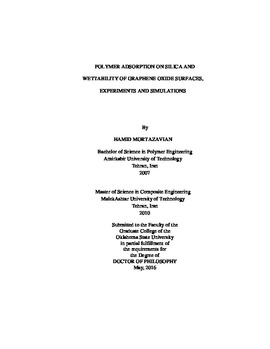| dc.contributor.advisor | Blum, Frank D. | |
| dc.contributor.author | Mortazavian, Hamid | |
| dc.date.accessioned | 2017-02-22T22:10:18Z | |
| dc.date.available | 2017-02-22T22:10:18Z | |
| dc.date.issued | 2016-05 | |
| dc.identifier.uri | https://hdl.handle.net/11244/48853 | |
| dc.description.abstract | Among the various classifications of polymer composites, studying polymers adsorbed to a surface such as silica is important due to their numerous applications. Adsorbed polymers usually show different properties than their bulk counterparts due to their interactions with the surface. In this study, we observed tightly- and loosely-bound polymer and mobile components in poly(vinyl acetate) (PVAc) on silica both with temperature-modulated differential scanning calorimetry (TMDSC) experiments and computer simulations. The more-mobile component which correlated to the region of low density at the air interface is reported for the first time using TMDSC thermograms. Pore size distribution and pore volume development of adsorbed PMMA samples showed different behavior below and above the tightly-bound amount of the polymer. The amount of tightly-bound polymer was obtained by a linear regression analysis of the ratio of the area under the two glass transitions. The values obtained vary from 0.52 to 0.86 mg PVAc/m2 silica depending upon the molecular mass for the amounts of PVAc and the specific surface area of fumed silica. | |
| dc.description.abstract | Direct comparisons of the thermal properties and intermolecular interactions were performed between PVAc and poly(methyl methacrylate) (PMMA) with similar molecular masses and adsorbed amounts on silica. A larger amount of tightly-bound polymer and a greater change in glass transition were observed for adsorbed PMMA compared to adsorbed PVAc. These observations suggested that the interactions between PMMA and silica were stronger than those between PVAc and silica. Molecular modeling of these surface polymers showed that PMMA associates more strongly with silica than does PVAc through additional hydrogen-bonding interactions. | |
| dc.description.abstract | Graphene oxide (GO) material surface characteristics make it easy to functionalize, making it a water repellant surface. To test the effect of chemical makeup and size of attached groups on the surface wettability of GO, we performed experimental water contact angle measurements and molecular modeling investigations on functionalized GO surfaces. Experimental and molecular simulation water contact angle measurements showed quantitative agreement for functionalizing groups with the same chain length at a variety of surface coverages. | |
| dc.format | application/pdf | |
| dc.language | en_US | |
| dc.rights | Copyright is held by the author who has granted the Oklahoma State University Library the non-exclusive right to share this material in its institutional repository. Contact Digital Library Services at lib-dls@okstate.edu or 405-744-9161 for the permission policy on the use, reproduction or distribution of this material. | |
| dc.title | Polymer adsorption on silica and wettability of graphene oxide surfaces, experiments and simulations | |
| dc.contributor.committeeMember | White, Jeffery L. | |
| dc.contributor.committeeMember | Nelson, Toby L. | |
| dc.contributor.committeeMember | Krishnan, Sadagopan | |
| dc.contributor.committeeMember | Gappa-Fahlenkamp, Heather | |
| osu.filename | Mortazavian_okstate_0664D_14567.pdf | |
| osu.accesstype | Open Access | |
| dc.type.genre | Dissertation | |
| dc.type.material | Text | |
| thesis.degree.discipline | Chemistry | |
| thesis.degree.grantor | Oklahoma State University | |
